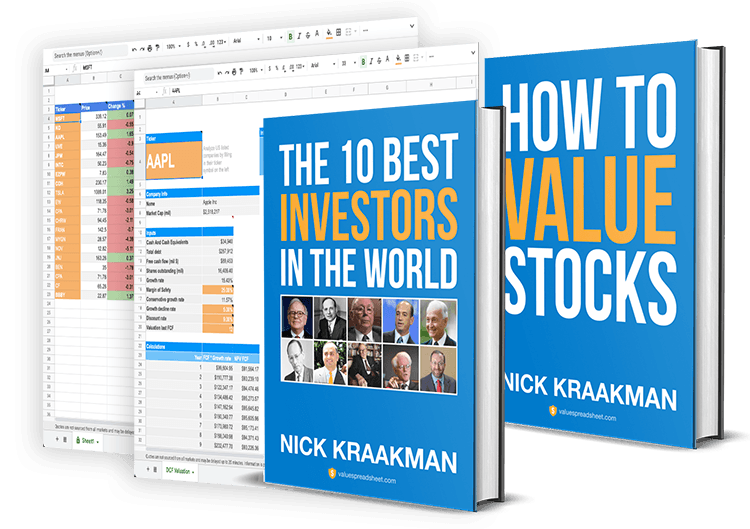
Diversification is a hot topic amongst investors. In this post I explain why accepted financial models are painfully inadequate to help you determine your optimal portfolio allocation strategy and what you should do instead.
Modern Portfolio Theory
Finance curriculums around the world hammer home the fact that diversification is one of the prime ways to minimize overall portfolio risk.
This practice, which is widely used in the financial industry, is called Modern Portfolio Theory (MPT).
This theory is, contrary to what the name might suggest, a severely outdated as well as highly ineffective method which significantly limits potential returns.
The reason why MPT is seriously flawed is because it defines risk as variance. MPT attempts to reduce fluctuations in the total portfolio return by offsetting losses from one asset by profits from an other asset and equates that to reducing risk.
However, value investors know that continuous fluctuations in the price of an asset are primarily caused by irrational, emotional behavior from investors and do not represent risk in and of itself.
Price fluctuations mean nothing, really.
The underlying business value is all that counts. To value investors price fluctuations represent opportunity rather than risk!
"Market prices are set by herds of emotional, greedy, or depressed persons who do not always act rationally."
Warren Buffett in The Superinvestors of Graham-and-Doddsville (1984)
Capital Asset Pricing Model
MPT is based on the equally ancient Capital Asset Pricing Model (CAPM), which describes the relationship between risk and expected return.
The so called trade-off assumption of CAPM states that in order for one to gain higher returns, one has to take bigger risks.
A humongous error once again, as evidenced in the subtitle of Mohnish Pabrai's magnificent book on value investing, The Dhandho Investor: The Low-Risk Value Method to High Returns.
In this book Pabrai explains how buying undervalued, yet fundamentally strong companies actually minimizes downside risk, because much negativity is already priced in, while maximizing upside potential, since the purchase price is far below the estimated value of the company.
This makes sense, doesn't it?
However, it is exactly the opposite of what CAPM, another widely used and widely taught model, tells us.
The verdict
Both CAPM and MPT are pretty mathematical models which look beautiful on paper, but are in fact utterly useless in the real world.
Both these models assume that markets are efficient and that investors always act rationally, two assumptions which have been proven to be absolutely incorrect by the emerging field of Behavioral Finance.
So if MPT is incorrect, this means that reducing fluctuations in portfolio returns through diversification does not necessarily reduce overall portfolio risk, but merely creates the illusion of a "smoother ride".
And if CAPM is incorrect, this means that we do not necessarily have to take bigger risks in order to achieve higher returns.
And if we can take less risks while getting equal or even higher returns this means we require less protection against risk, because there is less of it!
Practical tips
Warren Buffett once said that risk comes from not knowing what you're doing.
If this is you, if you don't know what you're doing, the way to reduce risk is not through diversification but through education.
Before you invest a penny on the stock market I strongly suggest you to invest some serious time in reading books on value investing written by the investment greats to learn from their years of success on the stock market.
When it comes to diversification, less is often more for several reasons.
First, it is rare to find great companies trading at discount prices, which is what you should be looking for if consistent market beating returns are your goal.
Since it is rare to find such bargains, it is impossible to compose a portfolio of say 40 of these great stocks, simply because there aren't that many opportunities out there! In this case diversification means buying less-than-great stocks simply for the sake of diversification, a practice which actually increases the overall risk of your portfolio rather than reduce it.
Second, having a long list of stocks in your portfolio makes it harder to stay on top of them all.
It makes it harder to know everything there is to know about all of these businesses.
A small portfolio is much easier to manage and you can actually become an expert on each of the companies you own.
Third, more companies equals more transaction costs, and transaction costs are the silent killer of portfolio returns.
Finally, the more stocks you own, the more your returns tend to converge to the average return of the stock market.
Since many people in the investment community seem to have the goal of "beating the market" on top of their list of priorities, having your returns converge to that average will seriously work against you in achieving this goal.
So, how many stocks should you own? My suggestion to you is 10 or less. I own just 4 stocks myself, because I trust in the analyses made with my favorite investment tool (**shameless self-promotion **).



